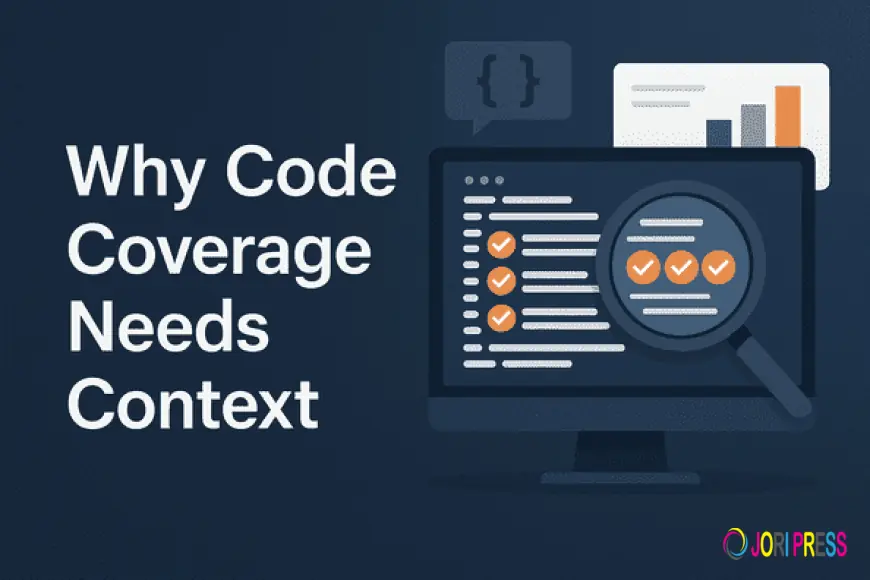Why Code Coverage Needs Context: The Missing Layer in Test Analytics
Code coverage alone can’t measure software quality. Discover why adding context and analytics to code coverage leads to better testing decisions, smarter QA strategies, and more reliable releases.

For years, code coverage has been the go-to metric for assessing how thoroughly software is tested. Teams proudly display their coverage percentages on dashboards, chasing 80%, 90%, or even the elusive 100%. But there’s a growing realization across the software engineering world: high code coverage doesn’t always mean high-quality testing. Without context—about what’s being tested, how, and why—the number alone can be misleading.
The future of test analytics demands more than raw metrics. It requires contextual intelligence—an understanding of how code coverage aligns with test effectiveness, defect density, risk, and user behavior.
The Problem with Treating Code Coverage as an Absolute
Code coverage measures the percentage of source code executed during automated tests. While useful for identifying untested areas, it doesn’t indicate whether the tests are actually validating the logic, catching bugs, or protecting critical paths.
For example, a test suite might execute every function in your codebase (achieving 100% coverage) but still fail to detect a key regression if assertions are weak or missing. Similarly, trivial tests—those that simply run methods without verifying outcomes—inflate coverage without improving reliability.
This is where context becomes essential. A line executed is not the same as a line validated.
Why Context Matters in Modern QA?
-
Not All Code Is Equal
Some parts of an application are mission-critical (like payment gateways or authentication systems), while others are low-risk (like log formatting). Contextual test analytics help prioritize coverage where failures have the greatest business impact. -
Understanding Coverage Gaps
Instead of simply flagging uncovered code, teams need insights into why certain areas are untested. Is it because they’re unreachable, low-risk, or hard to mock? Contextual metrics explain the gap rather than just exposing it. -
Balancing Depth and Breadth
Context helps differentiate between shallow coverage (simple execution) and deep coverage (thorough validation). This distinction guides QA teams to focus on meaningful assertions rather than line counts. -
Integrating with Production Insights
When combined with observability tools, code coverage data can reveal whether frequently used or high-traffic paths in production are adequately tested. This connection between test data and real-world usage gives QA a stronger foundation for prioritization.
The Role of Intelligent Analytics and AI
Artificial intelligence is reshaping how code coverage data is analyzed and acted upon. AI-driven test analytics platforms can correlate code coverage metrics with defect patterns, commit history, and performance regressions to highlight weak spots in the testing strategy.
For instance, if AI identifies that modules with lower coverage have historically produced more production bugs, it can recommend targeted testing improvements. Similarly, it can detect redundant test cases that add no new coverage value and suggest consolidation to improve CI/CD efficiency.
This contextual layer transforms coverage from a static measure into a predictive signal for code quality and reliability.
Code Coverage and Test Effectiveness: A Symbiotic Relationship
While code coverage tells you how much of the code is tested, test effectiveness reveals how well it’s tested. Contextualizing coverage with effectiveness metrics—like defect detection rate, mutation testing results, and test flakiness—provides a holistic view of quality.
For example, mutation testing tools introduce small changes (mutations) in the source code to verify whether tests catch them. If coverage is high but mutation scores are low, it means the tests are executing code without validating correctness—indicating false confidence.
This multi-dimensional approach helps teams shift focus from quantity to quality.
Contextual Code Coverage in Practice
Modern tools and methodologies are evolving to integrate contextual awareness into coverage analytics. Instead of simple “percentage” reports, advanced dashboards now correlate coverage data with code complexity, change frequency, and production telemetry.
For instance, pairing coverage data with version control insights allows teams to identify untested new code introduced in recent commits. Similarly, integrating it with error logs or APM data can surface critical code paths that are under-tested despite heavy real-world usage.
Open Source Innovation and Tools Like Keploy
Open source tools are leading the way in making test analytics more context-aware. Solutions like Keploy go beyond traditional coverage metrics by automatically generating API-level test cases from real traffic. This approach bridges the gap between development and production by ensuring that tests reflect real-world scenarios—adding a contextual layer to coverage data.
Keploy’s test generation mechanism also helps teams uncover untested API behaviors that matter most to end users, not just to internal logic. By correlating test data with API performance and reliability, it enhances the overall accuracy of code coverage insights.
This fusion of automation, observability, and intelligence is what turns coverage from a passive metric into an active enabler of software quality.
Building a Contextual Coverage Strategy
To make code coverage meaningful, teams should:
-
Prioritize by risk and impact, not just percentage. Focus on areas that affect users, security, or business-critical operations.
-
Combine coverage with other quality metrics like defect rates, test density, and mutation testing.
-
Integrate observability and production data into testing pipelines for contextual awareness.
-
Automate feedback loops so coverage insights guide future test creation automatically.
-
Leverage AI-driven analytics to identify redundant tests, risky modules, and actionable coverage gaps.
The Future of Test Analytics
As QA becomes more data-driven, metrics like code coverage must evolve from vanity numbers into contextual insights. The next generation of testing analytics won’t just measure execution—it will measure relevance, accuracy, and business impact.
In this future, teams will use coverage data not to boast about percentages, but to understand where testing truly contributes to reliability and user satisfaction.
Context doesn’t replace code coverage—it completes it. And that’s the missing layer modern test analytics can no longer afford to ignore.
What's Your Reaction?
 Like
0
Like
0
 Dislike
0
Dislike
0
 Love
0
Love
0
 Funny
0
Funny
0
 Angry
0
Angry
0
 Sad
0
Sad
0
 Wow
0
Wow
0

















































